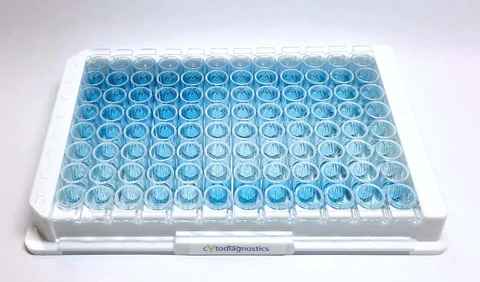ELISAs
ELISA Kits & Reagents

An ELISA (enzyme-linked immunosorbent assay) is a plate-based assay for detecting and quantifying soluble molecules such as antibodies, proteins, peptides, haptens and drugs.
In an ELISA, the antigen (molecule to be detected and quantified) is immobilized onto a solid surface (microplate) and then complexed with an antibody that is conjugated to a reporter enzyme (e.g., Horseradish Peroxidase). These complexes are then incubated with the appropriate substrate for the reporter enzyme to produce a measurable product. The most essential element of any ELISA is a highly specific antibody-antigen interaction.
Background
The enzyme linked immunosorbent assay (ELISA) is a highly sensitive method for detecting and quantifying a specific protein in a complex mixture such as plasma or serum. First developed by Engvall and Perlmann in 1971, the ELISA method allows for proteins to be immobilized onto wells of a microplate using specific antibodies and detected with an enzyme-conjugated antibody. ELISAs are typically performed in 96-well microtiter plates to which antibodies or proteins have been passively adsorbed. This immobilization and binding of reagents makes ELISAs easy to both design and perform. Having the components of the ELISA immobilized to the surface of a microplate makes it easy to remove and wash away non-bound material during the assay. This makes ELISA a powerful tool for the specific measurement of low abundance targets within a complex biological sample.
All ELISAs are composed of the same basic elements:
1) Coating/capture of antigens to the surface of microplate wells.
2) Plate blocking – to bind and cover all of the unsaturated surface-binding sites of the microplate wells not occupied by the capture antibody/protein.
3) Detection – incubation with an antigen-specific antibody that will bind specifically to the antigen.
4) Measurement of the signal – the signal generated by the reporter enzyme conjugated to the detection antibody is measured on a microtiter plate reader. The most commonly used enzyme labels are horseradish peroxidase (HRP) and alkaline phosphatase (AP). The choice of substrate to be used depends upon the sensitivity required to detect the antigen of interest as well as the instrumentation available, i.e. spectrophotometer, fluorometer, etc.
Cytodiagnostics, Inc. offers high-quality and fully optimized ELISA kits that allow you to reliably and consistently measure target-specific antibodies with confidence. A complete, ready-to-use kit for the detection of Rabbit IgG is currently available with other in development. In addition to the ready-to-use ELISA format, services such as: lot reservation, bulk packaging and custom target development are available to provide convenience to assist with your research needs.
References
Engvall, Eva, and Peter Perlmann. Enzyme-linked immunosorbent assay (ELISA) quantitative assay of immunoglobulin G. Immunochemistry 8.9 (1971): 871-874.
